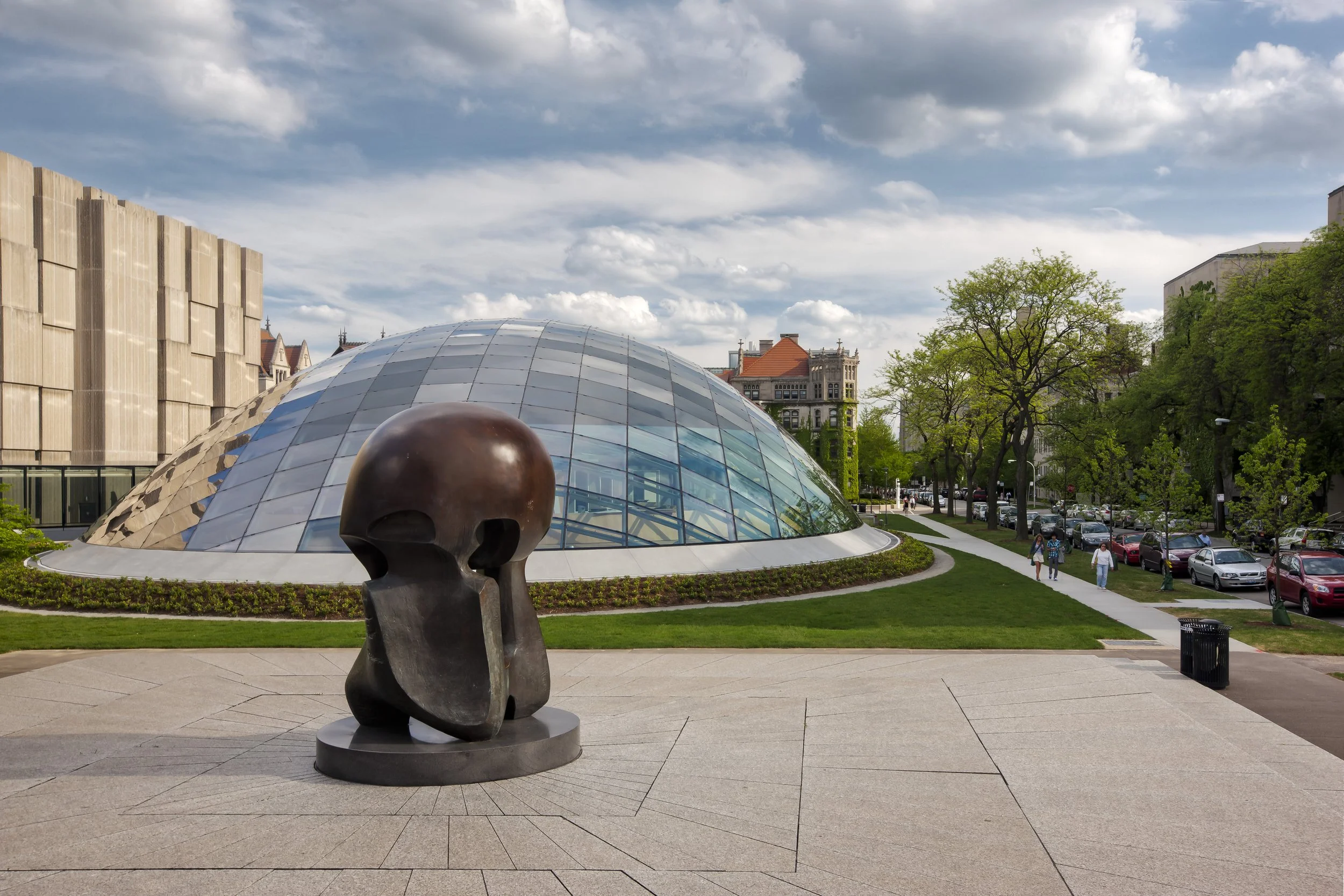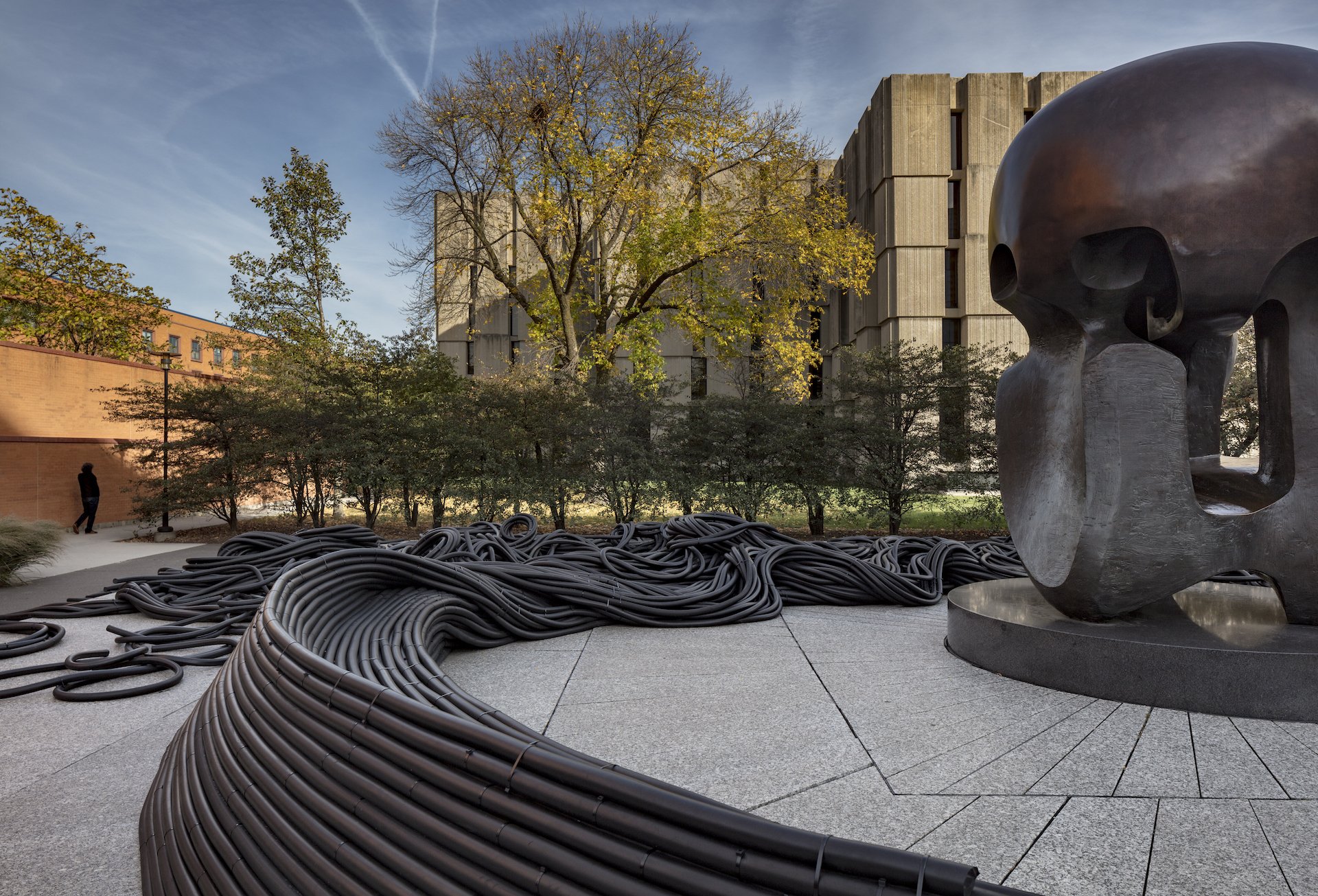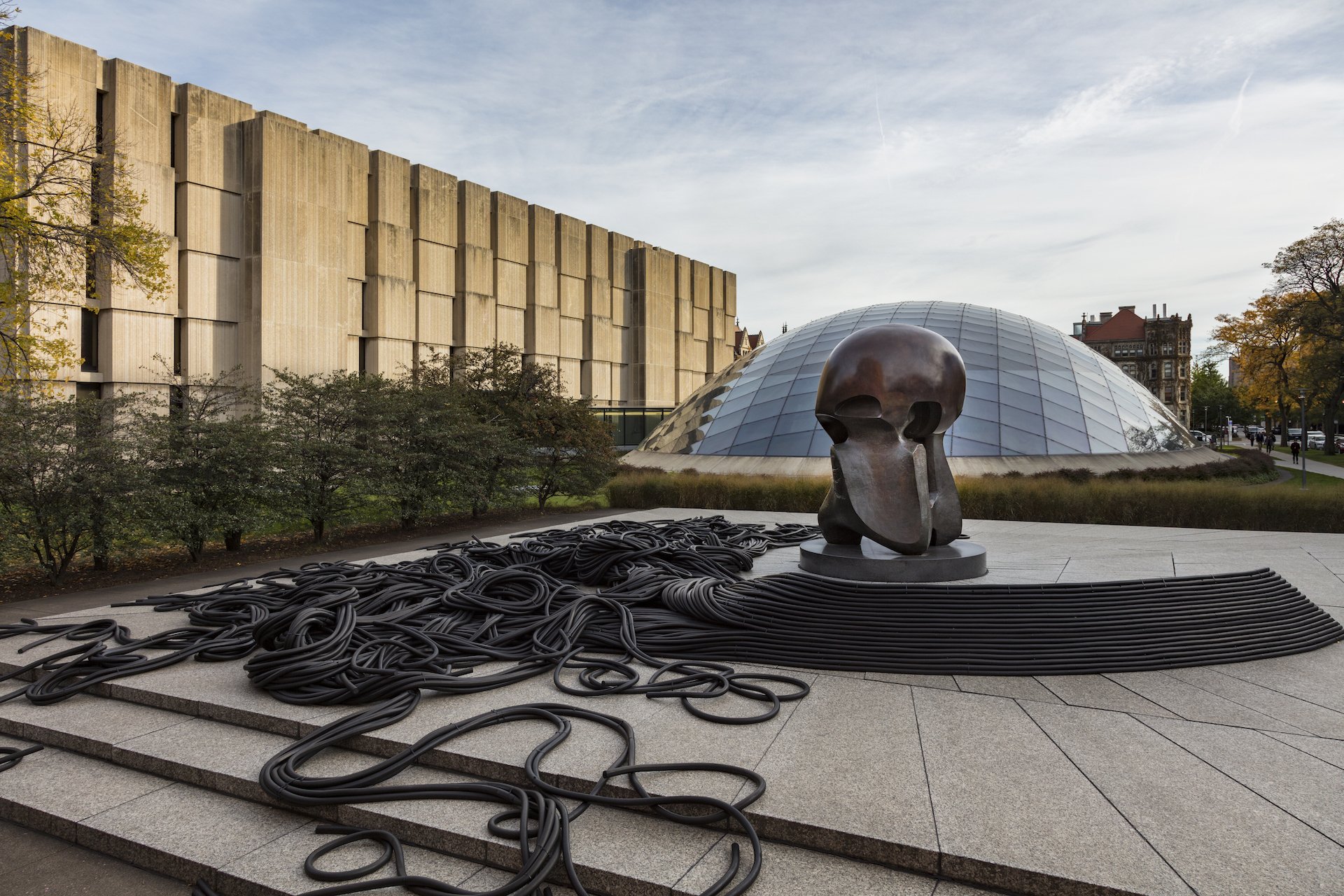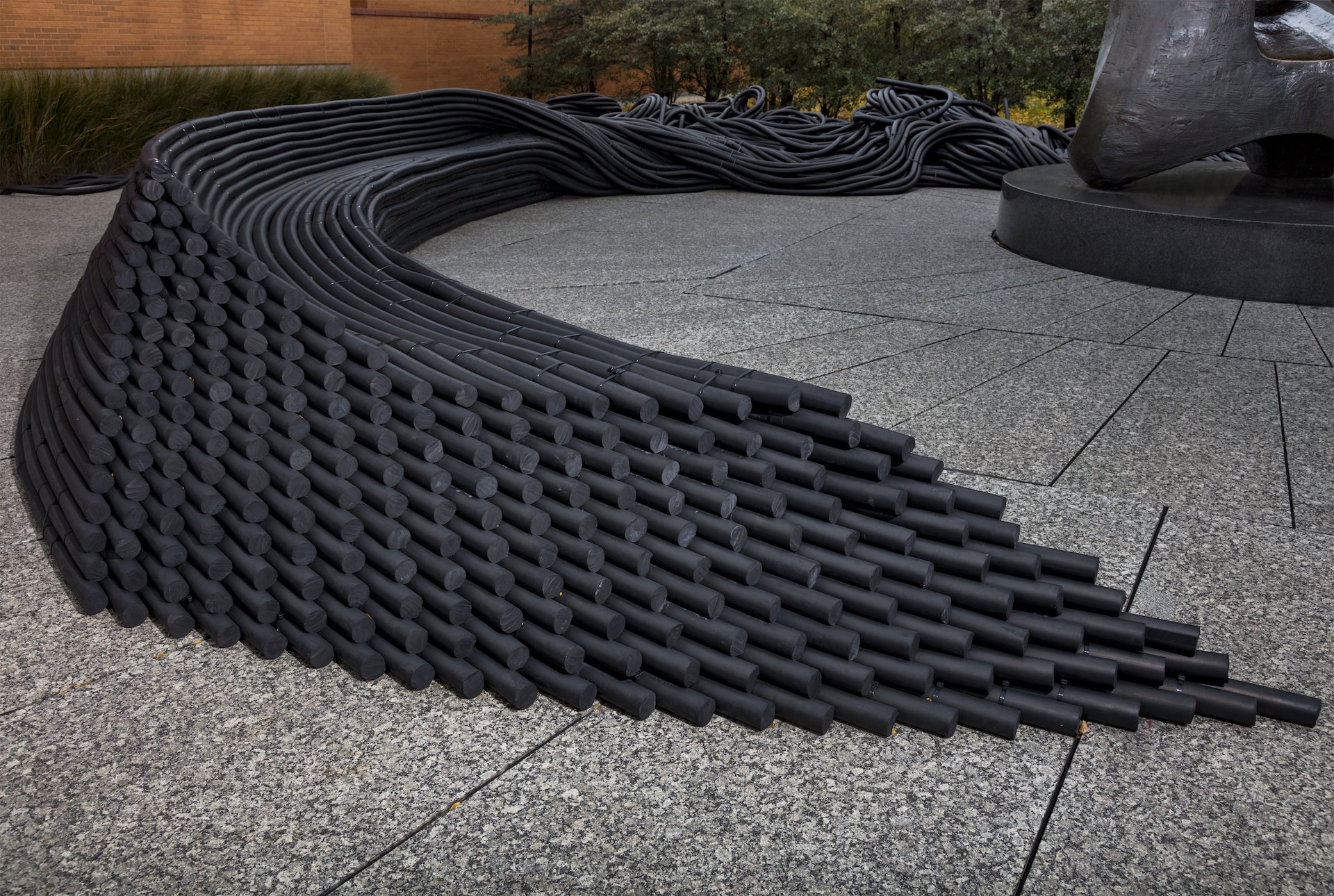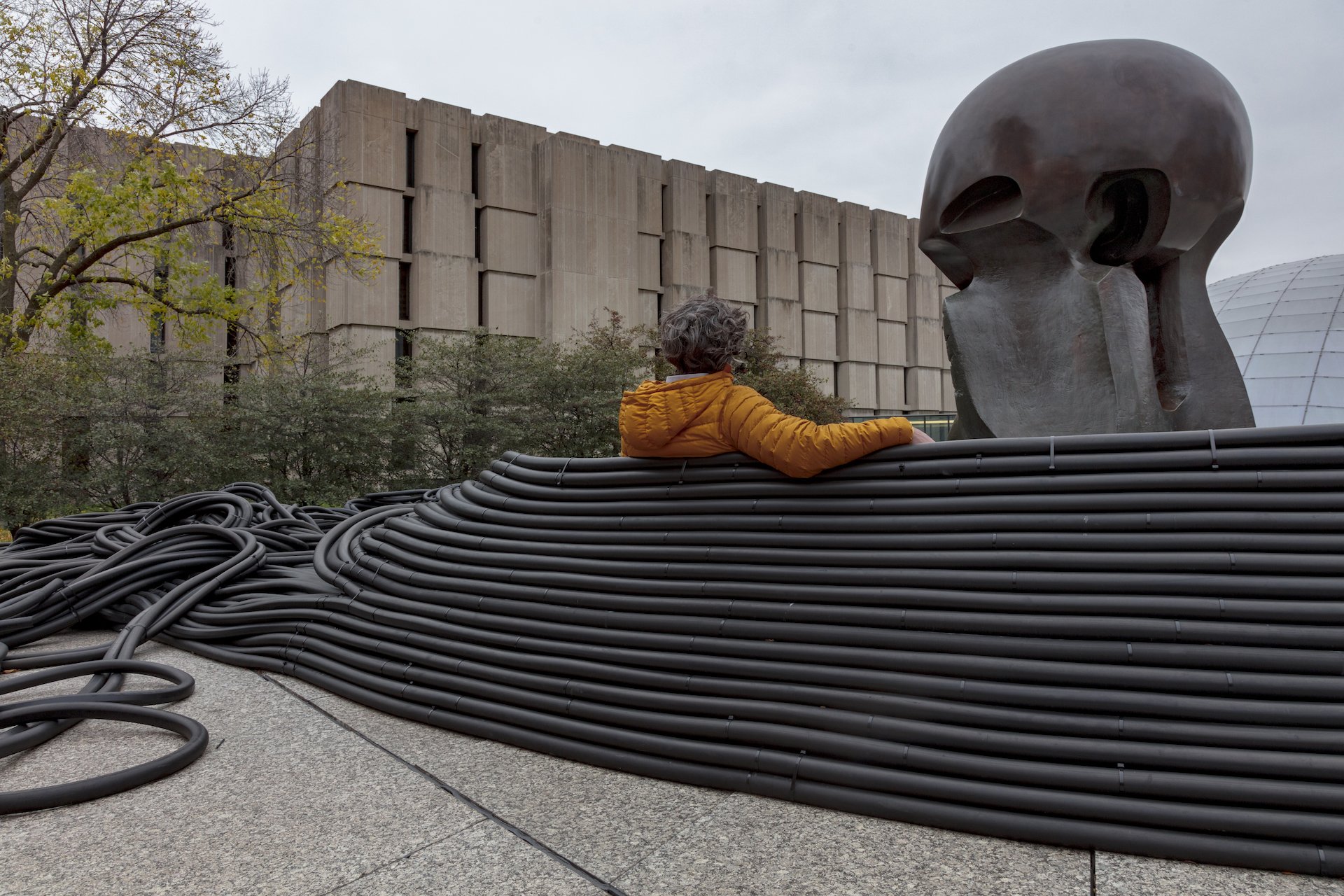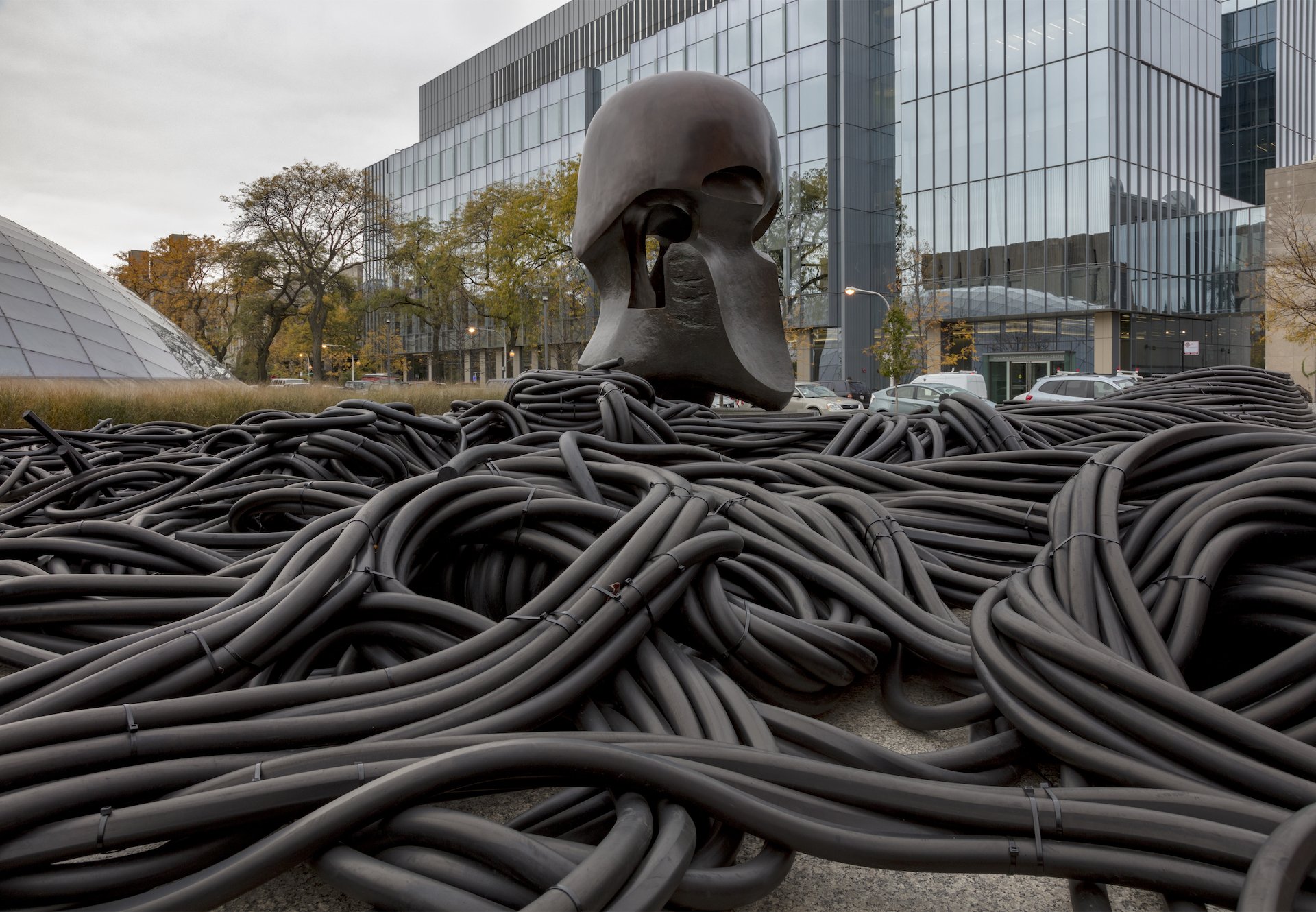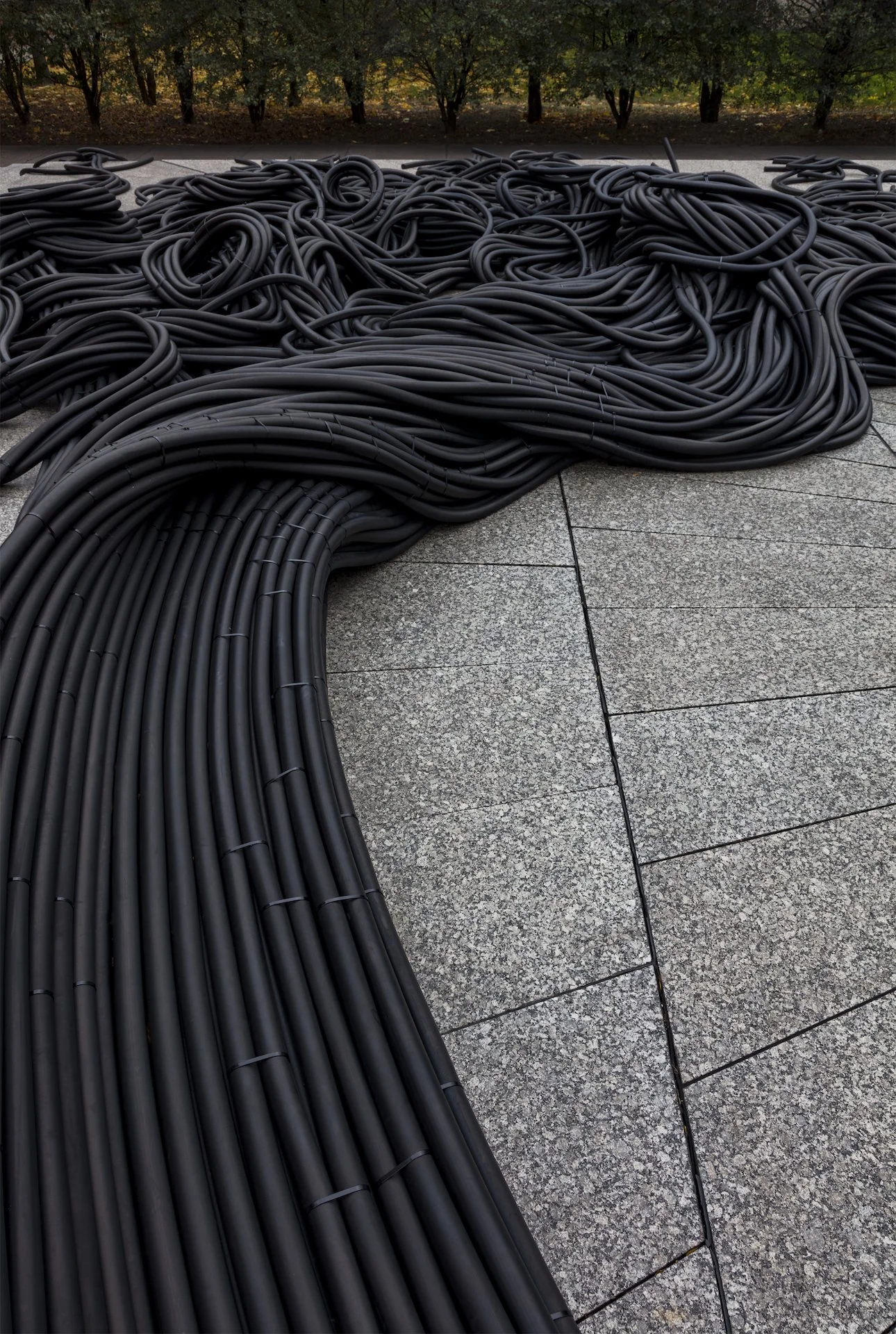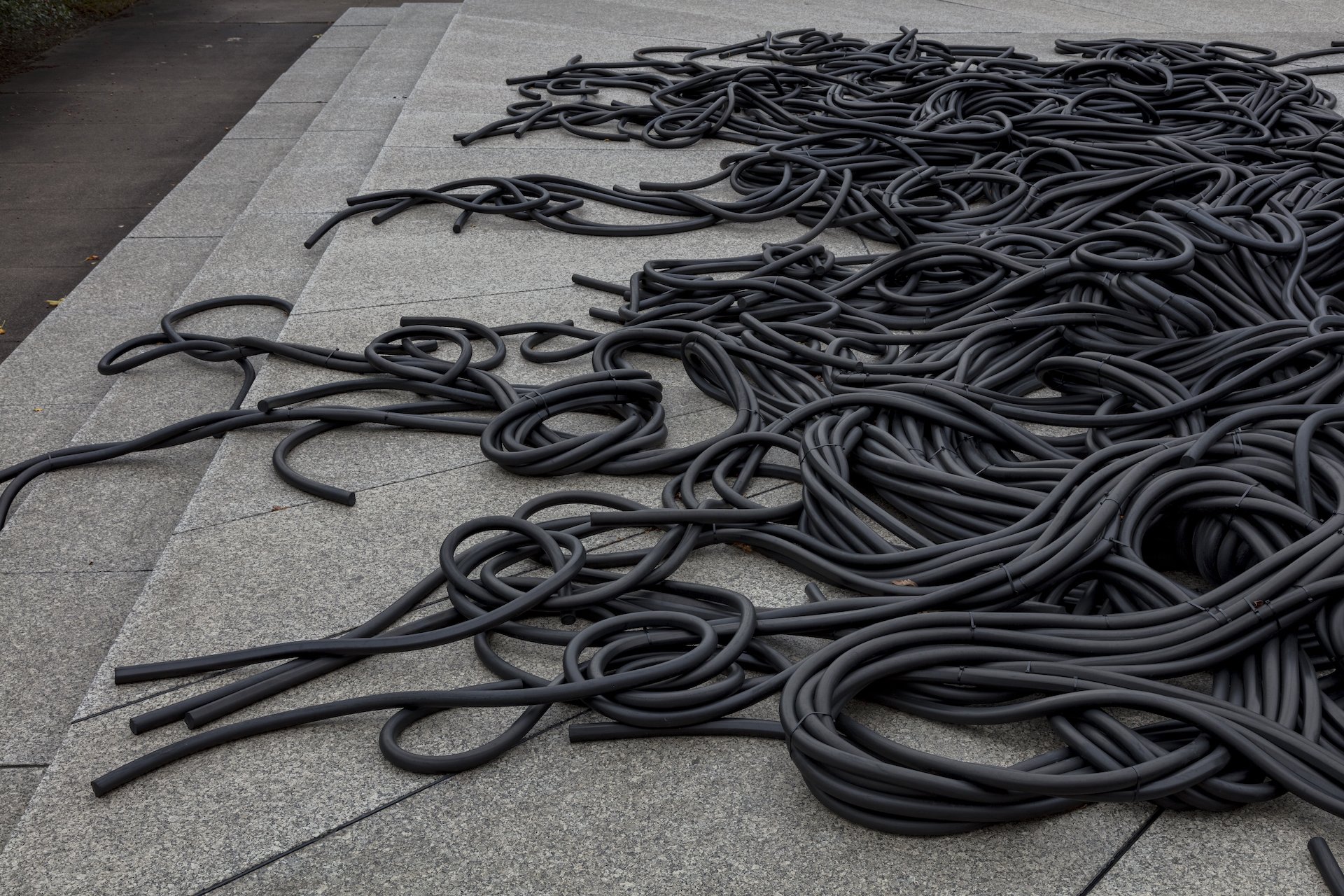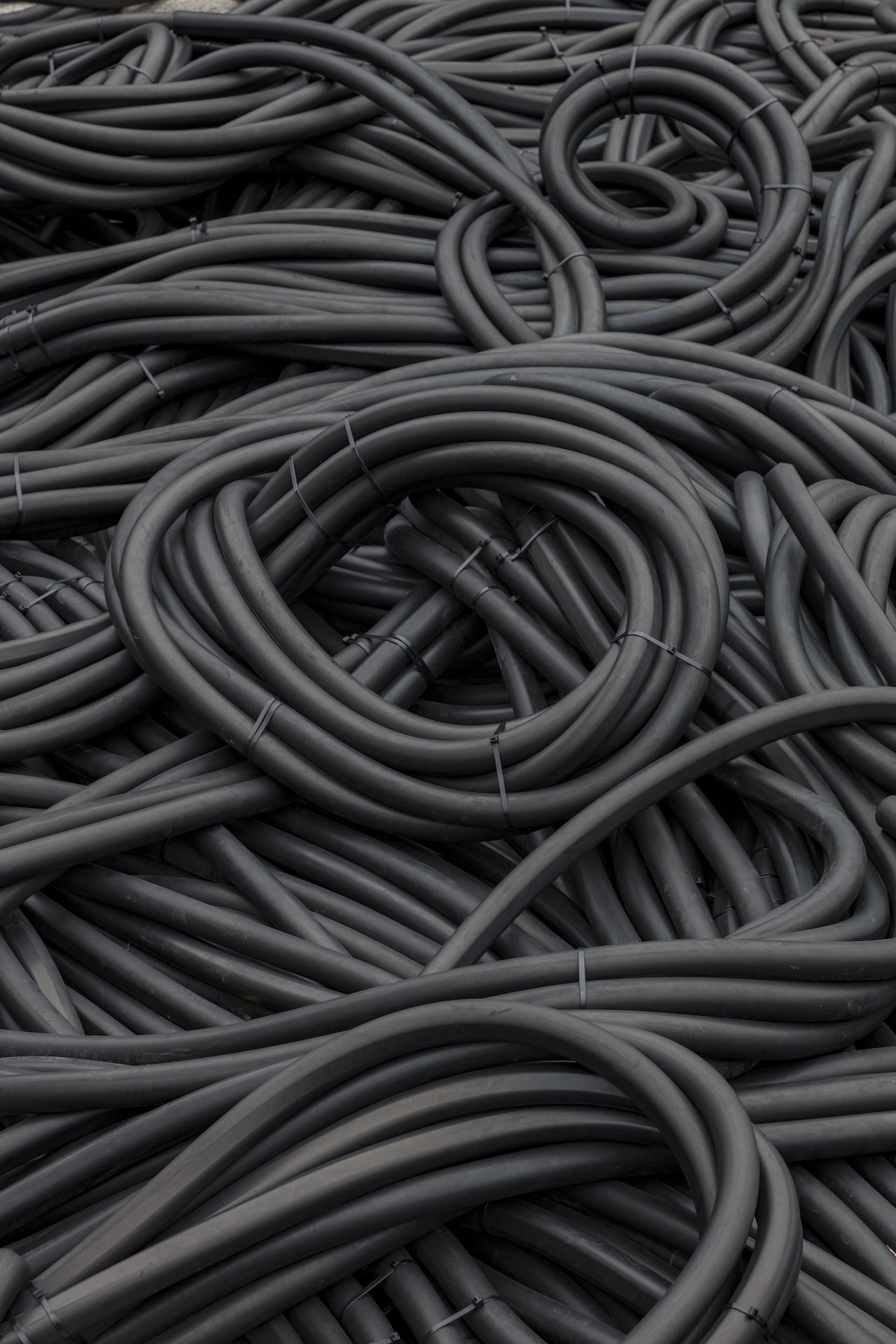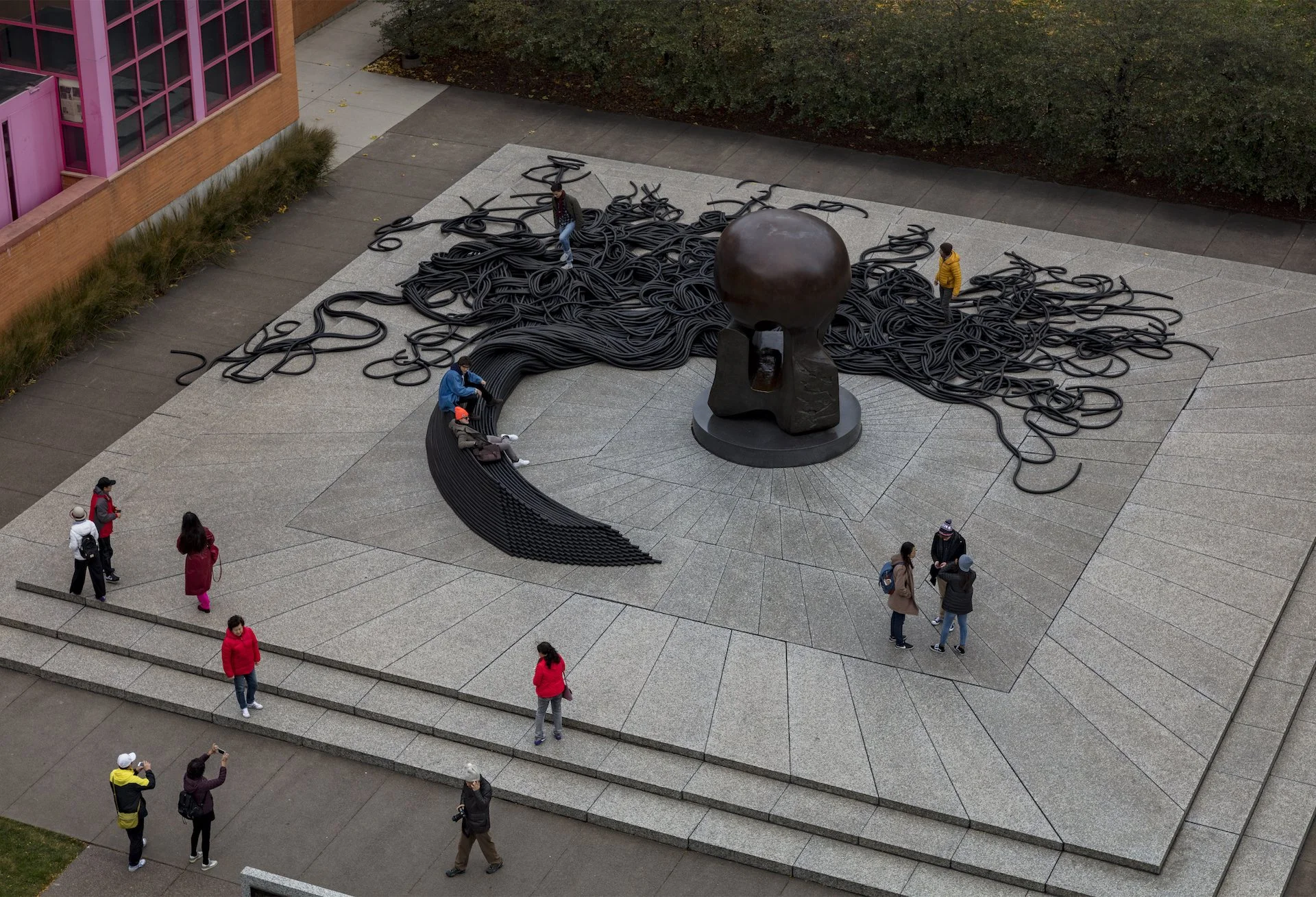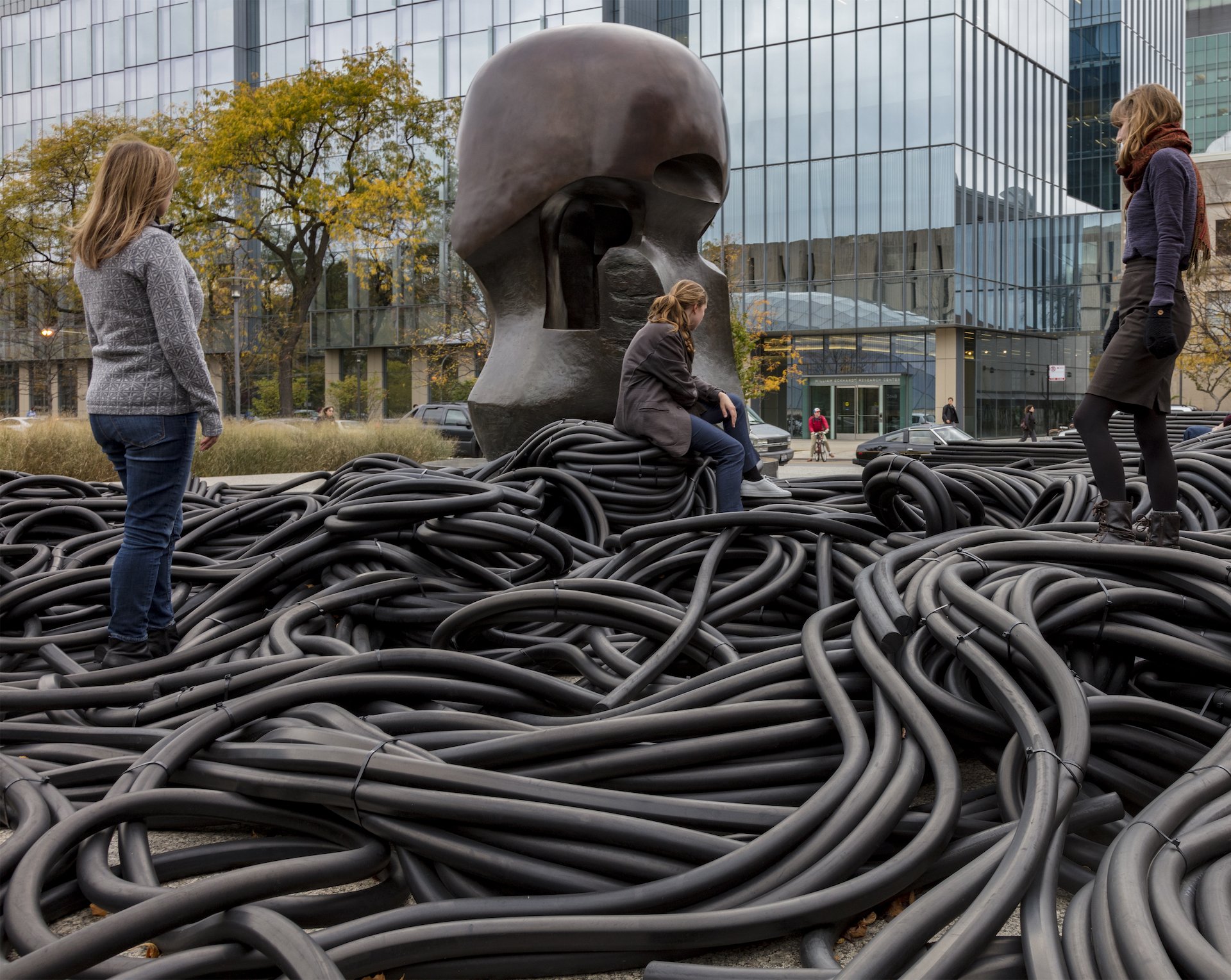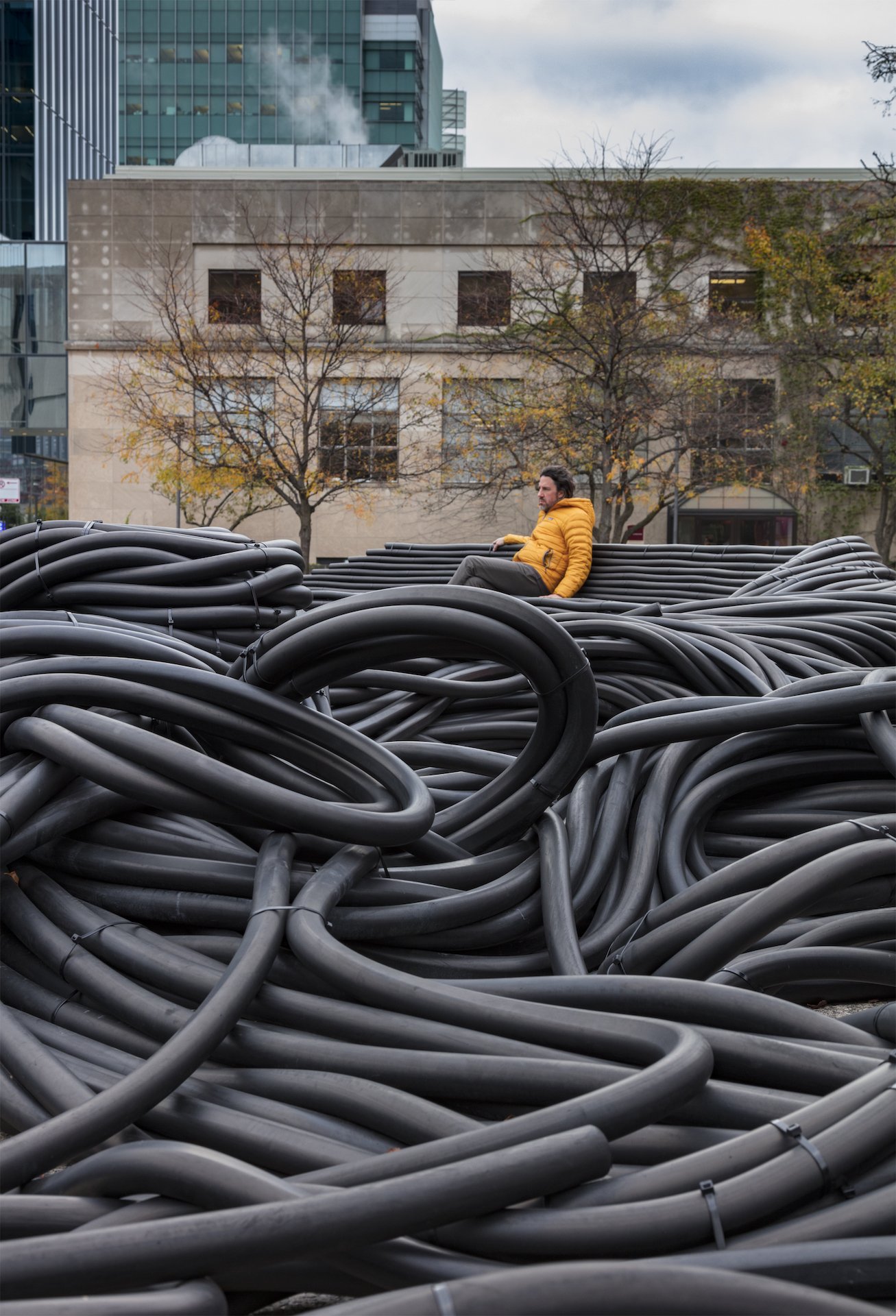September 18, 2017 – Spring 2018
Nuclear Thresholds
Ogrydziak Prillinger Architects (OPA)
Scholars discuss the scientists at the University of Chicago who, on December 2, 1942, achieved the first self-sustained nuclear chain reaction—as well as the implications of the historic experiment.
Henry Moore’s sculpture Nuclear Energy was installed in 1967 to commemorate the 25th anniversary of the first self-sustained nuclear reaction. The 12-foot tall bronze sculpture, which resembles a human skull or mushroom cloud, encapsulates both the hopes and the fears of atomic energy. To honor the sculpture’s 50th anniversary, San Francisco-based Ogrydziak Prillinger Architects installed a temporary commemorative piece called Nuclear Thresholds—hundreds of 75-five-foot-long cords of thick black rubber based on computational modeling of unstable processes.
nuclear energy
Henry Moore (1898-1986)
Created 1963-67 / Installed 1967
Bronze
Height: 144 in (365.8 cm)
Located on Ellis Avenue between 56th and 57th Streets
Provided by the trustees of the B.F. Ferguson Monument Fund, 1967
NUCLEAR THRESHOLDS
Ogrydziak Prillinger Architects (OPA)
Temporary installation: September 18, 2017 – Spring 2018
Material: black EPDM solid rubber cord; 241 strands, each 75 ft. long and 2 in. diameter
Dimensions: variable
Commissioned by UChicago Arts for Nuclear Reactions, the 75th anniversary of the first controlled, self-sustaining nuclear chain reaction.
Unveiled for the 2017 Chicago Architecture Biennial.
Commission made possible by the University's Public Art Committee.
“[Nuclear Energy] has a powerful capacity to keep the spectator in motion—drawing him around to the opposite side and, like many of Moore’s pieces, tempting one to crawl inside.”
— David Katzive, “Henry Moore's Nuclear Energy: the genesis of a monument”
Henry Moore's sculpture "Nuclear Energy" marks the site of the first self-sustaining, controlled nuclear chain reaction on Dec. 2, 1942. The sculpture is installed beside the Joe & Rika Mansueto Library on the UChicago campus. Photo: Tom Rossiter
nuclear energy
On December 2nd, 1942, a team of scientists led by Italian émigré Enrico Fermi set the world's first man-made, self-sustaining nuclear chain reaction in motion at Chicago Pile 1 (cp1), the world's first artificial nuclear reactor built under the original site of the University of Chicago’s Stagg Field. The event was a decisive step toward the creation of the age of atomic energy, and critically, at the time, to the production of the atomic bomb for use in World War II. Exactly twenty-five years later, on December 2nd, 1967, the sculpture Nuclear Energy was unveiled as a memorial to the accomplishments of Fermi and his fellow physicists.
The twelve-foot tall bronze sculpture was commissioned by the University of Chicago and created by British artist Henry Moore, one of the most preeminent public sculptors of his generation. Moore designed, modeled, and cast the sculpture between 1963 and 1967—in Moore's mind, it was both a celebration of this incredible human achievement, and also a warning against the dangers of harnessing such natural, physical power. In a commentary on the work, he said:
“Like anything that is powerful, it has a power for good and evil...the lower part [of the sculpture] is more architectural and in my mind has the kind of interior of a cathedral with sort of a hopefulness for mankind.”
-
In 1961, the University of Chicago's then-president George W. Beadle set up a committee to oversee the upcoming 25th anniversary of this momentous event. Until that point there had been only a small plaque hanging on a fence to mark the site, so the search committee was instructed to look for an artist who could create a full-scale monument. Professor of History William McNeill, a key figure on the committee, approached several sculptors including Henry Moore to see if they would be interested in the task. Moore accepted the offer, and in December of 1963, Professor McNeill traveled to Moore's studio where he had already started work on a maquette (small scale model) that would later become the basis for Nuclear Energy.
Moore created Nuclear Energy in the same way he did many of his other public sculptures at the time. Working almost exclusively in plaster, he initially created a small maquette that would then be scaled up and cast in bronze. As Nuclear Energy was a particularly complex piece, Moore took the work to be cast in Berlin by the master founder Hermann Noack. The difficult process took around ten months to complete, with the work first cast in 50-60 separate pieces that then had to be welded together. Like an enormous 3-D jigsaw puzzle, the fit of the pieces had to be perfect to create a seamless appearance in the overall shape. After construction, the sculpture was then patinated, a process that involves the application of chemicals to the surface of the bronze to produce a particular color and finish. The final color of the work was important to Moore, though he realized corrosion on the surface could be an issue (due to the natural chemical reaction that turns bronze green in color). On this subject he noted that “We can retain [the patina] to some extent by keeping it clean.” Cleaning and waxing the sculpture is still a vital responsibility for the University today.
Even before Nuclear Energy had been cast in bronze, an image of the working maquette was circulated at the University. In June 1965, the University committee overseeing the budget for the memorial viewed a photograph of the proposed sculpture for the first time, and the piece met with a certain amount of resistance. According to archived minutes of the meeting, there was no consensus as to the meaning of the monument, since Moore's intentions for the work appeared ambiguous. Concerns were raised that, because of the ‘mushroom cloud’ shape of the upper part of the piece, the work could become strongly associated with the atomic bomb rather than Enrico Fermi's scientific achievement at the University. The media were quick to pick up on these tensions—headlines from the time stirred the potential controversy: “Fermi Statue Creates Furor at U. of C.,” read one, and “Is the Memorial Menacing or Just a Mushroom?” asked another. In such articles, Nuclear Energy was seen as potentially threatening and frightening. “Henry Moore touches a sensitive area,” wrote one journalist when questioning the sculpture's suitability as a memorial to scientific advancement, and in an era of Cold War politics, the work was seen by some as divisive.
Writing to Professor McNeill in that same year, Moore confirmed some of these interpretations of the work's formal qualities:
“As a general principle I prefer to let my work speak for itself, but sometimes it is possible to give a hint of what was in one's mind in making the sculpture. In this, the upper part is very much connected with the mushroom cloud of an atomic explosion, but also, it has the shape and eye sockets of a skull.”
Later, in a 1972 conversation, however, Moore described the other half of the crucial complementary ideas that inspired the Nuclear Energy maquette, which is titled “Atom Piece”:
“One might think of the lower part of it being a protective form and constructed for human beings and the top being more like the destructive side of the atom. So between the two it might express to people in a symbolic way the whole event.”
The duality of ideas outlined here by Moore can be seen as an elaboration on his series of ‘helmet-head’ themed sculptures that he had been producing throughout the 1940s. These smaller-scale helmet bronzes, representing the military equipment that protects the human head, can provide further context to the meaning of Nuclear Energy. There is a striking similarity between the upper section of Nuclear Energy and these earlier works, indicating a development of ideas from the helmet forms into the larger architectural sculpture. It is because of this duality that many people at the University also defended the work's depiction of the complicated birth of atomic power. Harold Haydon, a Professor of Art and the Director of the Midway Studios at the time, wrote:
“No single photograph does justice to this monumental sculpture; every change of viewpoint reveals new order and complexity...Certainly, the great bronze will mark a point in time and space this is [sic] without doubt, a watershed in the history of mankind.”
Thanks to the support of University faculty members like Haydon and the B.F. Ferguson Fund at The Art Institute of Chicago, Nuclear Energy was revealed to the public in December 1967 and has had a lasting impact as a powerful testimony to one of the most important scientific developments in the history of the University of Chicago and of the world.
Written by Alice Kain
-
-
Bach, I. & Gray, M. “A Guide to Chicago's Public Sculptures”, 1983, University of Chicago Press.
Hedgecoe, J. “A Monumental Vision: The Sculpture of Henry Moore”, 1998, Stewart Tabori & Chang.
-
Burnell, H. “Sculpture of Atomic Birth Creates Stir at U. of C.”, Chicago Sun Times, September 26, 1965.
Haydon, H. “Henry Moore: An Appraisal”, University of Chicago Special Collections, Nuclear Energy Archive.
Katzive, D. “Henry Moore's Nuclear Energy: The Genesis of a Monument”, Art Journal, 32.3, (Spring 1973), pp. 284-288.
McNeill, William H. Papers, Box 1, Folder 3, Special Collections Research Center, University of Chicago Library.
“Nuclear Thresholds,” by Ogrydziak Prillinger Architects (OPA). Commissioned for the 75th anniversary commemoration of the first controlled, self-sustaining nuclear chain reaction, and for the 2017 Chicago Architecture Biennial. Photo: Richard Barners.
nuclear THRESHOLDS
Throughout Fall 2017, UChicago Arts and the University's Public Art Committee, in partnership with the Chicago Architecture Biennial, present a series of temporary installations on campus that explore the complex legacy of the Chicago Pile-1 experiment, including Nuclear Energy, Henry Moore's sculpture that was created to mark the experiment's 25th anniversary.
Architects’ Statement
Nuclear Thresholds commemorates the 75th anniversary of Enrico Fermi’s “Chicago Pile–1”—the first man-made, self-sustaining nuclear chain reaction. The project brief invited us to both reflect on the nature of the experiment, as well as the tension between control and the loss of control engendered by the birth of the Nuclear Age. Essentially, the project is a protean pile of material that begins as a simple arc and then dissolves into exponential complexity.
In developing the project, we thought about chain reactions, and the random walks of liberated neutrons. We thought about critical mass, when a chain reaction is barely self-sustaining, and supercriticality, the turning point when the rate of fission increases, sometimes to the point of being out of control. We were interested in the complex materiality embodied in the original experiment: the tightly-packed pile of graphite used for the experiment, as well as thinking about matter as something not solid but composed largely of space and energetic particles. The incongruous siting of this existentially pivotal experiment in a squash court captured our imaginations. Finally, we also wanted to pay homage to the Henry Moore sculpture by intensifying the site and partially enframing it on its vast plinth.
The installation consists of 241 two-inch diameter, seventy-five-foot-long cords of EPDM rubber. The cords are close-packed in a hexagonal array, forming a simple arc that serves as a bench. The bench invites contemplation and directs focus to the Henry Moore Nuclear Energy sculpture in the center of the plinth. After forming a quarter of circle, the form splits into two branches that explode the regular, controlled form of the arc. Those two branches then each twist and split into two more branches, and so on, exponentially increasing the complexity of the overall form until all the cords are writhing freely.
I think there are a lot of different ways into thinking about the installation, and hopefully visitors will pick up some reference that interests them and pulls them into deeper contemplation. It’s something of a puzzle, and is intended to provoke questioning of some of the assumptions we have about the physical world and our role within it.
—Ogrydziak Prillinger Architects (OPA)
Nuclear Thresholds
September 18, 2017–January 7, 2018
Outdoors at the Nuclear Energy sculpture, 5625 S Ellis Ave
In-progress artist talk at the site on September 16, 2pm
As part of the 75th anniversary of Chicago Pile-1 (the site of the first man-made, self-sustaining nuclear chain reaction), UChicago Arts and California-based firm Ogrydziak Prillinger Architects (OPA) present a temporary architectural installation at the location of the original pile, marked for the last fifty years by Henry Moore's Nuclear Energy sculpture. Based on computational modeling of unstable processes, the installation creates a material threshold around Nuclear Energy that resonates at radically different scales. It invites visitors to interact physically with the shape and patterns of criticality that drove the experiment, provoking deep questions about the scientific, historical, and existential thresholds CP-1 crossed. Installation opens during the Chicago Architecture Biennial. Presented by UChicago Arts. Nuclear Thresholds is made possible by the University's Public Art Committee.
Lantern Pile
November 15–December 15, 2017
Eckhardt Research Center lobby, 5640 S Ellis Ave
UChicago Arts presents an installation that provided an intimate space to view video documenting both the creation of Chicago Pile-1 and the subsequent history of the nuclear era. Lantern Pile takes its roughly cubic form from the original pile, in which heavy wooden beams supported a dense structure of graphite bricks that made the inducement of sustained nuclear fission possible. In contrast, this installation is an empty cube constructed of white paper and bamboo poles, lifted several inches above the lobby floor. Visitors can enter the Lantern Pile to view four different channels of video documentation, much of it newly discovered. The installation’s form and materials echo that of a Japanese paper lantern, and the video projected inside is visible outside like a candle in a lantern, providing space for personal reflection on Fermi’s achievement and the ramifications of living in a nuclear age. Presented by UChicago Arts. Curated by Laura Steward.

